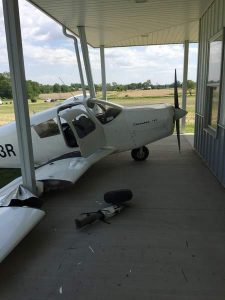 Not everyone wants to conform to the rigid (and in some cases minimalistic) requirements of a “residential” (according to the Building Codes) airplane hangar. While a bit more work, a Building Permit can often still be obtained.
Not everyone wants to conform to the rigid (and in some cases minimalistic) requirements of a “residential” (according to the Building Codes) airplane hangar. While a bit more work, a Building Permit can often still be obtained.
Some permit issuing jurisdictions are tougher than others. In the case of an aircraft hangar which does not meet the criteria of a residential hangar (typically over 2000 square feet or greater than 20 feet tall), do not be surprised to have to go through a more extensive review – bigger building, more hoops to jump through.
While RDP (Registered Design Professional – engineer or architect) sealed plans and calculations may not have been required for a hangar which met the requirements for a residential hangar, do not be shocked to find they will be necessary for larger hangars.
Often a more thorough structural plan review, by the Building Department, will be in order. Extra sets of plans may be required as well. Besides the structural drawings, a full site plan, architectural drawings and plumbing, mechanical and electrical drawings are typically required.
Aircraft hangars shall be considered an S-2 occupancy and shall comply with IBC (International Building Code) Section 412.2 and all other applicable sections of the Code to include but not limited to the following (keep in mind every jurisdiction could have some variability from these);
Exterior walls located less than 30’ from property lines shall have a fire-resistance rating not less than 2-hours.
If located on the same lot as a one- or two- family dwelling, the hangar shall be separated from the residential building as follows;
(Attached) 2-hour fire resistant rated construction, 1-1/2 hour rated door assembly.
(Detached with less than 20’ separation distance between hangar and dwelling unit) 1 to 2 hour fire rated walls and openings based on the location of the assumed property line.
(Detached and 20’ or more separation distance between hangar and dwelling unit) no rating required.
Heating equipment shall be placed in another room separated by 2-hour fire-resistant rated construction. Entrance shall be from the outside or by means of a vestibule with a two-doorway separation. In the case of unit heaters suspended at least 10 feet above the upper surface of wings or engine enclosures of the highest aircraft which may be housed, or at least eight feet above the floor in shops, offices and other sections of the hangar communicating with storage or service areas, a single interior door shall be allowed, provided the sources of ignition in the appliances are at least 18” above the floor.
Floor surfaces shall be graded and drained to prevent water or fuel from remaining on floor. Floor drains shall discharge through an oil separator to the sewer or to an outside vented sump.
Fire suppression shall be required per NFPA 409 as follows;
Any hangar having an aircraft access door exceeding 28 feet in height.
Any hangar exceeding one story in height.
Any hangar where hazardous operations including fuel transfer, welding, torch cutting, torch soldering, doping or spray-painting are performed.
Careful planning starts with consulting with your Planning & Building Departments, to get their advice and direction on how to move forward with the greatest of ease on your large aircraft hangar. Nothing is insurmountable, but without their “blessing”, it could end up being a lesson in frustration.






